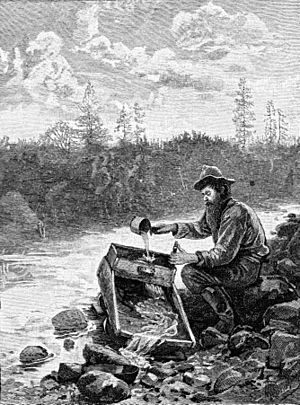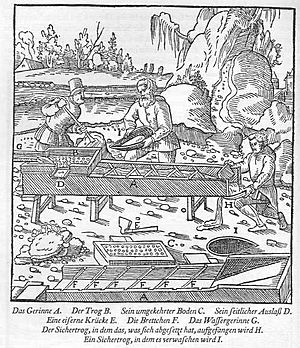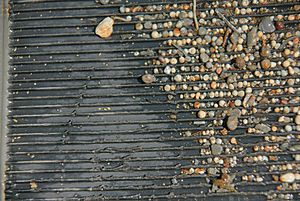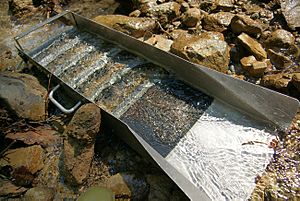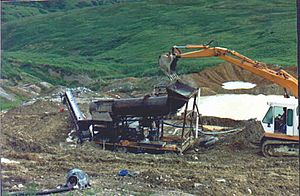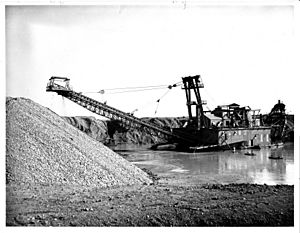Placer mining facts for kids
Placer mining is a way of finding valuable minerals, like gold or gemstones, in places where they have been naturally collected by water. Think of it like a treasure hunt in riverbeds, old streams, or even ancient glacial deposits!
These minerals are often found in sand and gravel because they are much heavier than other materials. When water flows, it carries lighter things away, but the heavy gold and gems sink and gather at the bottom of these deposits. This makes them easier to find.
Placer deposits can be very new, like those found on some beaches, or incredibly old, like those that are billions of years old! Sometimes, the ground holding these minerals is too loose to dig tunnels. But if the ground is frozen solid, like in permafrost areas, miners can dig underground. When there's a lot of water available, miners can use a method called hydraulic mining. This uses powerful jets of water to break up the ground and wash out the valuable minerals.
Contents
History of Placer Mining
For a long time, placer mining was the main way people found gold. The ancient Romans, for example, used powerful water methods called hushing to find gold across their empire. One huge Roman mining site was at Las Médulas in Spain. They built seven long aqueducts (water channels) to bring water to the gold deposits!
In North America, placer mining became very famous during the big "gold rushes." These included the exciting California Gold Rush and the Klondike Gold Rush. Thousands of people rushed to these areas hoping to strike it rich!
Today, placer mining is still done in many parts of the world. People find diamonds, industrial minerals, platinum, and gold in places like Yukon, Alaska, and British Columbia. They also find beautiful gems in countries like Myanmar and Sri Lanka.
Where Gold Deposits Are Found
Gold is very heavy, so it often settles in places where water flow slows down, like in stream beds. Miners look for gold in different types of placer deposits. These deposits are popular because they can be less expensive to mine.
Residual Deposits
Residual deposits are found where rocks have broken down due to weather, but water hasn't carried the gold away yet. The gold is still very close to its original source rock.
Alluvial Deposits
Alluvial deposits are the most common type of placer gold. They are also often the richest! This is where gold pieces have been washed away from their original rock by water. They then settle in sand and gravel in or near rivers, streams, or old riverbeds. You'll often find these in valleys or flood plains.
Bench Deposits
Bench deposits are like old stream beds that are now high up on slopes, sometimes even on mountain tops! This happens when a river changes its course over a very long time, leaving its old bed (with the gold) much higher than the new river. Many miners today focus on finding gold in these bench deposits.
How Placer Mining Is Done
Miners use several different methods to get gold and gems out of the ground. These methods help them dig up the material and then separate the valuable minerals from the dirt and rocks.
Panning for Gold
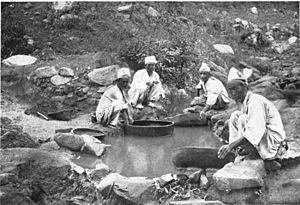
The simplest way to find gold is by panning. This method has been used for thousands of years! To pan, you put some dirt and gravel into a large metal or plastic pan. You add water and gently shake the pan. Because gold is heavier, it sinks to the bottom. Then, you carefully wash away the lighter sand and gravel, leaving the gold behind.
Panning is great for finding where gold might be. However, it's very slow. Even an expert can only process a small amount of material in a day. So, once a good spot is found, miners usually switch to bigger equipment.
Using a Rocker Box
A rocker box, also called a "cradle," can process more material than a gold pan. It's like a bigger, more efficient pan. A rocker box sits on curved pieces of wood, allowing it to be rocked back and forth. This rocking motion helps separate the gold. Miners would often call it "rocking the golden baby."
A typical rocker box is about 42 inches long. It has a removable tray where the gold is collected. Rocker boxes were popular during early gold rushes because they were portable. However, they can only process about 3 or 4 cubic yards of gravel a day, which is still not a huge amount.
Sluice Box Mining
A sluice box uses the same idea as panning but on a much larger scale. It's a long, narrow box with special barriers called "riffles" along the bottom. Miners shovel dirt and gravel into one end, and water flows through the box. As the water carries the lighter material away, the heavy gold particles get trapped by the riffles.
Sluice boxes can be a few feet long or much longer. They can handle more material than pans or rocker boxes. However, traditional sluice boxes might only catch about 40% of the gold. During the California Gold Rush, sluice boxes were used a lot for bigger mining operations. Later, improved versions were made to catch more gold.
Dry Washing for Gold
What if there's no water? In dry areas, miners use "dry washing" methods. Instead of water, they use air to separate the gold. One common method is the Mexican dry wash. Gravel is placed on a board with riffles, and a bellows (like a big air pump) is used underneath. The air blows away the lighter sand, leaving the heavier gold behind. This method is simple but slow and not very efficient.
Using a Trommel
A trommel is a large, rotating metal tube that's slightly tilted. It has a screen at one end. Miners feed the ore (the dirt with minerals) into the higher end. Water is added, and as the trommel spins, the water and the spinning motion break up the ore. The valuable minerals pass through the screen, and then they are collected in smaller devices like sluices. Larger rocks that don't fit through the screen are carried away.
Gold Dredges
For very large amounts of material, miners use huge machines called gold dredges. These were once enormous boats that could process massive amounts of riverbed. Today, smaller, more flexible dredges are common. These often suck up water and gravel through long hoses using a pump. The gold is then separated using methods like a sluice box.
Underground Placer Mining
In places where the ground is always frozen, like in Siberia or Alaska, placer deposits can be mined underground. Since the frozen ground is too hard to dig by hand, miners historically built fires to thaw it. Later, they used jets of steam, called "points," to melt the frozen ground before digging.
Environmental Effects
In modern placer mining, companies often try to protect the environment. They might recycle the water they use and put the leftover dirt (called "tailings") back where it came from. This helps reduce harm to the land. However, not all mining operations do this.
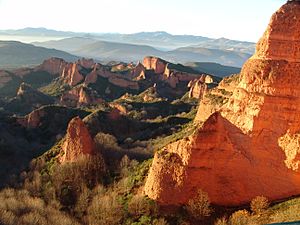
Long ago, miners didn't worry as much about the environment. For example, the ancient Roman gold mine at Las Médulas is now a UNESCO World Heritage site because of how spectacular the remains are. But the Roman writer Pliny the Elder noted that the mining methods caused a local lake to become heavily filled with silt (fine dirt).
Environmental groups often say that hydraulic mining can be very damaging. It adds huge amounts of silt to streams that were once clear. Today, most placer mines use "settling ponds." These ponds allow the silt to settle out of the water before it's returned to the environment.
In California, from 1853 to 1884, hydraulic mining moved so much material that it raised the level of parts of the Central Valley by about seven feet! This caused big problems, and eventually, a court case in 1884 banned flushing mining waste into streams. This ended the big hydraulic mining era in California.
Examples of Placer Deposits
- The Witwatersrand Basin in South Africa is a famous example of an ancient placer deposit. It's a 3-billion-year-old basin that holds at least 70 different valuable minerals.
- The Klondike Gold Rush started in 1896 when gold nuggets were found in the Klondike region of Alaska and the Canadian Yukon. The gold was found in running water, making it an alluvial placer deposit. About 30,000 gold-seekers rushed to the area!
Images for kids
-
A placer mine in Alma, Colorado in 1880.


